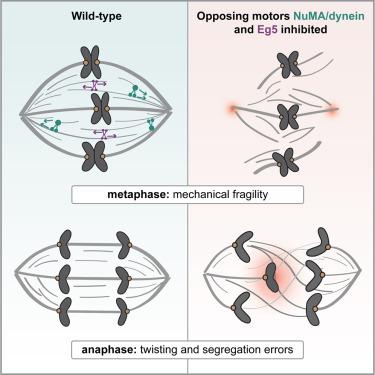Developmental Cell ( IF 10.7 ) Pub Date : 2021-10-05 , DOI: 10.1016/j.devcel.2021.09.011 Lila Neahring 1 , Nathan H Cho 2 , Sophie Dumont 3

|
At each cell division, the spindle self-organizes from microtubules and motors. In human spindles, the motors dynein and Eg5 generate contractile and extensile stress, respectively. Inhibiting dynein or its targeting factor NuMA leads to unfocused, turbulent spindles, and inhibiting Eg5 leads to monopoles; yet, bipolar spindles form when both are inhibited together. What, then, are the roles of these opposing motors? Here, we generate NuMA/dynein- and Eg5-doubly inhibited spindles that not only attain a typical metaphase shape and size but also undergo anaphase. However, these spindles have reduced microtubule dynamics and are mechanically fragile, fracturing under force. Furthermore, they exhibit lagging chromosomes and a dramatic left-handed twist at anaphase. Thus, although these opposing motors are not required for spindle shape, they are essential to its mechanical and functional robustness. This work suggests a design principle whereby opposing active stresses provide robustness to force-generating cellular structures.
中文翻译:

相对的电机提供人体主轴的机械和功能稳健性
在每次细胞分裂时,纺锤体从微管和马达中自组织。在人体纺锤体中,马达动力蛋白和 Eg5 分别产生收缩和伸展应力。抑制动力蛋白或其靶向因子 NuMA 导致不聚焦、湍流纺锤体,抑制 Eg5 导致单极子;然而,当两者同时受到抑制时,就会形成双极纺锤体。那么,这些相反的马达的作用是什么?在这里,我们生成了 NuMA/动力蛋白和 Eg5 双重抑制的纺锤体,它们不仅获得了典型的中期形状和大小,而且还经历了后期。然而,这些纺锤体具有降低的微管动力学并且机械脆弱,在力下断裂。此外,它们在后期表现出滞后的染色体和戏剧性的左旋扭曲。因此,虽然主轴形状不需要这些相对的电机,它们对其机械和功能的稳健性至关重要。这项工作提出了一种设计原则,即相反的主动应力为产生力的细胞结构提供了鲁棒性。











































 京公网安备 11010802027423号
京公网安备 11010802027423号